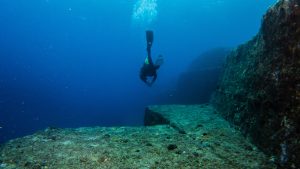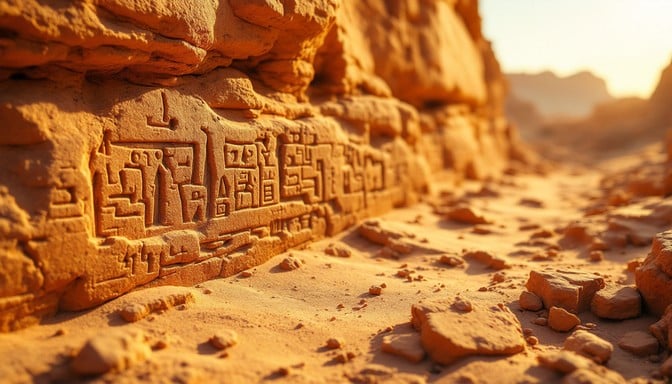 With over 70 percent of the planet being covered by water, across the millennia some man-made structures have been have been claimed by nature. An example, the Yonaguni Monument. Commonly referred as the “Yonaguni (Island) Submarine Ruins”, the structure was discovered in the mid-80s near the Yonaguni Island of Japan. It presents itself as a submerged rock formation and it lies approximately one hundred kilometres east of the island of Taiwan (Wikipedia).
With over 70 percent of the planet being covered by water, across the millennia some man-made structures have been have been claimed by nature. An example, the Yonaguni Monument. Commonly referred as the “Yonaguni (Island) Submarine Ruins”, the structure was discovered in the mid-80s near the Yonaguni Island of Japan. It presents itself as a submerged rock formation and it lies approximately one hundred kilometres east of the island of Taiwan (Wikipedia).
Man-made Formation
The structure is well defined by its rectangular shape and is approximately around 165 feet (50 metres) long and some 65 feet (20 metres) wide. Throughout the years, the rectangular monument has been visited by scholars that still dispute the possible origin and function of the structure.  According to some, the monument is a man-made stepped pyramid. In addition to many straight lines, some of the rocks purportedly have carvings. Nearby are other formations, suggesting a submerged ancient city. This theory contends that the structures are at least 5,000 years old and belong to a lost civilization—possibly the legendary Mu or Lemuria (Britannica).
According to some, the monument is a man-made stepped pyramid. In addition to many straight lines, some of the rocks purportedly have carvings. Nearby are other formations, suggesting a submerged ancient city. This theory contends that the structures are at least 5,000 years old and belong to a lost civilization—possibly the legendary Mu or Lemuria (Britannica).
Natural Formation
However, other researcher claim that the monument is natural because shaped over time by the local strong underwater currents. These researchers often refer to the symmetry of the rocks not being as pronounced as reported and that the structure appears to be made out of a single solid rock rather than distinct blocks, which would suggest human activity. The scale of the structure does not appear to be in proportion to humans, it lacks the symmetry that people normally apply to their works and it resembles the sandstone cliffs above it. Although, it might also be entirely possible that in a distant past the structure could have been modified by people for some unknown purpose, so that it contains some man-made features.  Another common argument is that, on a closer inspection, the alleged carvings of the structure appear as naturally occurring scratches. Or could have been deteriorate underwater and over time?
Another common argument is that, on a closer inspection, the alleged carvings of the structure appear as naturally occurring scratches. Or could have been deteriorate underwater and over time?
Controversy
The formation and the origin of the structure are still controversial and debated. Another proposed theory evaluates the possibility that the submerged stones might be the ruins of the Japanese Atlantis – an ancient city that sunk by an earthquake more than 2,000 years ago. It is the belief of the marine geologist at the University of the Ryukyus in Japan, Masaaki Kimura. He has been diving at the site to measure and map its formations for more than 15 years. Mister Kimura believes the ruins date back to at least 5,000 years, based on the dates of stalactites found inside underwater caves that he says sank with the city. Missing pieces of the puzzle might come from structures similar to the ruins sitting on the nearby coast that have yielded charcoal dated to 1,600 years ago—a possible indication of ancient human inhabitants, Kimura added.
References
___________________________________________________________________________________
- Miguel Angel Prieto, 1985, Archeology of Yonaguni Jima, Japan https://www.academia.edu/17039163/_PRIETO_M.A.1985_ARCHAEOLOGY_OF_YONAGUNI_JIMA._JAPAN
- Naotomo Umewaka, Yasmin El-Beih, 2021, BBC, Cómo es Yonaguni, la misteriosa “ciudad” sumergida de Japón https://www.bbc.com/mundo/vert-fut-57300178
- Julian Ryall, 2007, National Geographic, Japan’s Ancient Underwater “Pyramid” Mystifies Scholars https://www.nationalgeographic.com/history/article/yonaguni-jima-japan-underwater-city
- The Editors of the Encyclopedia Britannia, Yonaguni Monument, https://www.britannica.com/topic/Yonaguni-Monument
- Wikipedia, The Free Encyclopedia, Yonaguni Monument https://en.wikipedia.org/wiki/Yonaguni_Monument






One Response